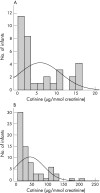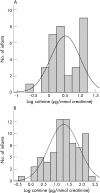Effect of parental smoking on cotinine levels in newborns
- PMID: 17580319
- PMCID: PMC2675401
- DOI: 10.1136/adc.2006.108506
Effect of parental smoking on cotinine levels in newborns
Abstract
Background: Smoking is a major risk factor for cot death. Many infants smoke passively as a result of parental smoking. This paper reports on infants exposed to a smoking environment and how they accumulate metabolites of cigarette smoke, such as cotinine, which may be physiologically harmful.
Aim: To assess cotinine levels in infants of smoking parents.
Method: Cotinine excretion in urine was assessed in 104 infants, of whom 71 had smoking parents and 33 had non-smoking parents. All cotinine levels were measured at approximately 12 weeks of age. The subjects were selected from a database of infants in developmental physiological studies which assessed the impact of various factors on early postnatal development.
Results: On average babies with at least one parent who was a current cigarette smoker excreted 5.58 (95% CI 3.4 to 9.5) times as much cotinine in the urine as did the babies of non-smoking parents. Maternal smoking was the largest contributing factor. Co-sleeping (p = 0.037) and the minimum room temperature (p = 0.028) were significant contributory factors.
Conclusion: Infants from smoking households accumulate cotinine, a metabolite of nicotine, which may have a detrimental effect on the cardiorespiratory system.
Conflict of interest statement
Competing interests: None.
Similar articles
-
Biomarkers of exposure to passive smoking of school children: frequency and determinants.Indoor Air. 2005 Oct;15(5):302-10. doi: 10.1111/j.1600-0668.2005.00361.x. Indoor Air. 2005. PMID: 16108902
-
Measuring the exposure of infants to tobacco smoke. Nicotine and cotinine in urine and saliva.N Engl J Med. 1984 Apr 26;310(17):1075-8. doi: 10.1056/NEJM198404263101703. N Engl J Med. 1984. PMID: 6708988
-
Household smoking behaviours and exposure to environmental tobacco smoke among infants: are current strategies effectively protecting our young?Aust N Z J Public Health. 2010 Jun;34(3):269-73. doi: 10.1111/j.1753-6405.2010.00525.x. Aust N Z J Public Health. 2010. PMID: 20618268
-
Passive smoking and sudden infant death syndrome: review of the epidemiological evidence.Thorax. 1997 Nov;52(11):1003-9. doi: 10.1136/thx.52.11.1003. Thorax. 1997. PMID: 9487351 Free PMC article. Review.
-
Animal models used to test the interactions between infectious agents and products of cigarette smoked implicated in sudden infant death syndrome.FEMS Immunol Med Microbiol. 1999 Aug 1;25(1-2):115-23. doi: 10.1111/j.1574-695X.1999.tb01334.x. FEMS Immunol Med Microbiol. 1999. PMID: 10443499 Review.
Cited by
-
Animal models for assessment of infection and inflammation: contributions to elucidating the pathophysiology of sudden infant death syndrome.Front Immunol. 2015 Mar 30;6:137. doi: 10.3389/fimmu.2015.00137. eCollection 2015. Front Immunol. 2015. PMID: 25870597 Free PMC article. Review.
-
Bedsharing may partially explain the reduced risk of sleep-related death in breastfed infants.Front Pediatr. 2022 Dec 13;10:1081028. doi: 10.3389/fped.2022.1081028. eCollection 2022. Front Pediatr. 2022. PMID: 36582509 Free PMC article. No abstract available.
-
Effects of postnatal smoke exposure on laryngeal chemoreflexes in newborn lambs.J Appl Physiol (1985). 2010 Dec;109(6):1820-6. doi: 10.1152/japplphysiol.01378.2009. Epub 2010 Sep 23. J Appl Physiol (1985). 2010. PMID: 20864563 Free PMC article.
-
Effect of a family-centered, secondhand smoke intervention to reduce respiratory illness in indigenous infants in Australia and New Zealand: a randomized controlled trial.Nicotine Tob Res. 2015 Jan;17(1):48-57. doi: 10.1093/ntr/ntu128. Epub 2014 Aug 25. Nicotine Tob Res. 2015. PMID: 25156527 Free PMC article. Clinical Trial.
References
-
- Mannino D M, Homa D M, Redd S C. Involuntary smoking and asthma severity in children: data from the Third National Health and Nutrition Examination Survey. Chest 2002122409–415. - PubMed
MeSH terms
Substances
LinkOut - more resources
Full Text Sources
Medical
Miscellaneous


